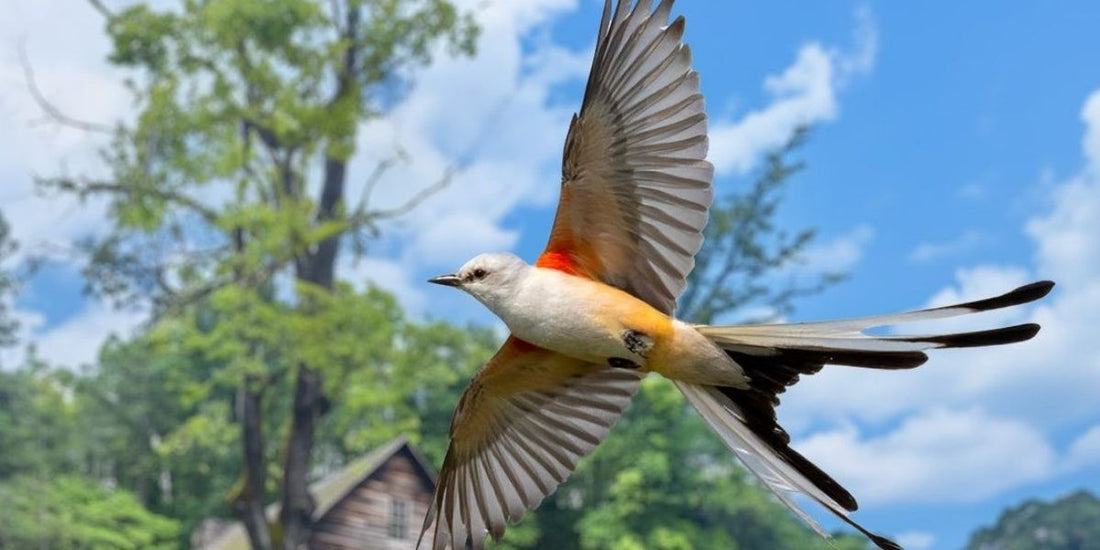
Strange Birds Are Being Sighted Throughout the Smoky Mountains
Share
Rare birds known as 'accidentals' are known to make rare sightings in the mountains of East Tennessee
You see a flitter of color. You hear the distant echo of a song. Unless you’re a birder, it won’t mean much to you other than a moment of beauty to brighten the day. As someone who has lived in the area for more than 30 years, I also can take our feathered friends for granted. But in doing so, I miss out on a chance for something really rare. In other words, an accidental aka a vagrant.
While more than 240 species of birds have been documented in the Smoky Mountains, not all of them are regulars. Some use the mountains as a pit stop along their migratory paths. But others are even rarer. Birds whose natural territory exists far from the Smoky Mountains. Maybe they blew in on the winds of a massive storm. Maybe the species is spreading, looking instinctively for new lands to call home. These "strange" birds are called accidentals.
Editor's Note: The featured image is a composition by TheSmokies.com staff.
IN THIS ARTICLE

What is an Accidental bird?
Essentially, an accidental is a bird that doesn’t belong in the area where you find it. Also called vagrants – accidentals can appear without notice, surprising birders and park enthusiasts alike. It’s like the Central Park Mandarin Duck – a member of an East Asian species that appeared in New York. Accidentals can attract large amounts of attention simply by being in the wrong place.
How do Accidentals happen? Well, when you can fly, you can travel great distances. In the mountains, accidentals can blow in with the remnants of a hurricane or tropical storm. Other times, conditions during migration can cause a change that leads a bird to seek refuge in the mountains. Sometimes the young birds will become vagrants while following a food source or acceptable climate. There are also birds born with deficiencies that affect their internal GPS. The in-built generations of knowledge tell them where they are supposed to be.
However, assuming a vagrant bird is lost or defective misses the science of species dispersal can change over time. The vagrancy isn’t an accident at all. It’s the fringe of an expanding and growing population.

Strange bird sightings in the Smokies
In January 2024, the Asheville Citizen-Times cited a Limpkin spotted in the mountains last fall. The limpkin, a shorebird known for its scream-like call, was seen in Cades Cove. Smokies Science Coordinator Paul E. Super told the newspaper that there are a couple of possibilities. Either the limpkin came in on the winds of a hurricane, like flamingoes seen in Alabama, Pennsylvania, and North Carolina last year. Or the species is expanding its range. And maybe it’s the latter. The Citizen-Times reports a pair of birds were seen in Western North Carolina and several more around Maryville. Possibly another in Knoxville.
But the limpkin isn’t the only vagrant spotted in the Mountains. The newspaper reports other accidentals spotted over the years, including a scissor-tailed flycatcher, a chestnut-collared longspur and a Townsend’s solitaire. And, with the size of the park and many visitors not up on their ornithology, there could be vagrants that go unnoticed every year.
The National Park Service has documented over 240 species, including 60 year-round residents. The list is expanding. In 2016-17, for example, park officials documented the long-eared owl and the Ross Goose for the first time.

How to identify strange birds
Want to get involved in identifying birds? The park service says you’ll hear more birds than you see. It recommends a free app from the Cornell Lab of Ornithology which can help with identification. When in the park, keep your eyes – and ears – on a swivel and you may experience something you’ve never encountered before.